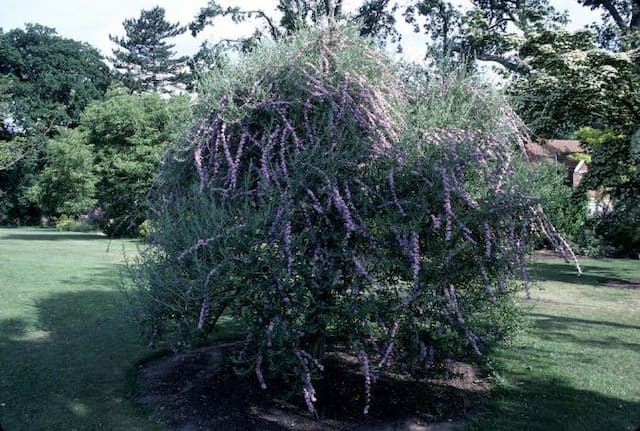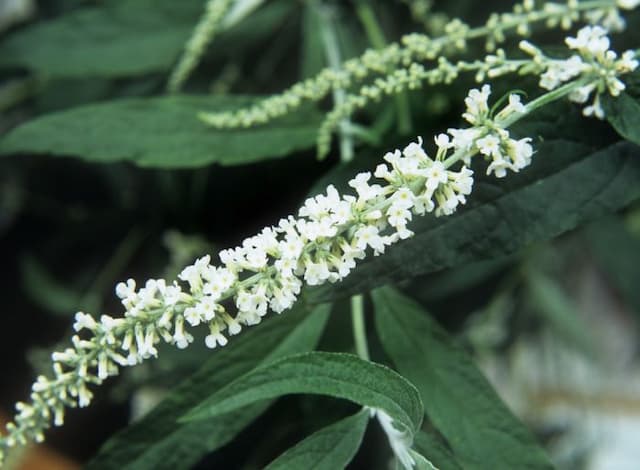Butterfly Bush Buddleja davidii Florence = 'Watflor'
![butterfly bush [Florence]](/_next/image?url=https%3A%2F%2Fplants-admin.emdemapps.com%2Fimages%2Fplants%2F%2Fimages%2F604b5f52d7bb1.png&w=3840&q=75)
ABOUT
Commonly known as Butterfly Bush, the plant is recognized for its generous clusters of fragrant, tubular flowers that bloom in a rich lavender-purple hue. The flower clusters are elongated and taper to a point, somewhat resembling a lilac in shape and are often teeming with butterflies and other pollinators during the blooming season. Leaves of this plant are lance-shaped with a pointed tip and a textured surface, providing a lush green backdrop that contrasts beautifully with the vibrant blooms. This deciduous shrub has a gracefully arching growth habit, with branches that bear flowers along their length, giving the plant a bountiful and slightly wild appearance. The overall impression of the Butterfly Bush is one of an abundant and lively plant that is a magnet for wildlife, adding both color and activity to any garden space.
About this plant
 Names
NamesFamily
Scrophulariaceae
Synonyms
Butterfly Bush, Summer Lilac, Orange Eye
Common names
Buddleja davidii Florence = 'Watflor'.
 Toxicity
ToxicityTo humans
Butterfly bush (Buddleja davidii) is generally not considered toxic to humans. There are no widespread reports of poisoning from ingestion of this plant. Therefore, incidental contact or consumption of small quantities of butterfly bush typically does not lead to serious health issues. However, as with many plants, individual allergic reactions or sensitivities are possible, so it is advisable to be cautious.
To pets
Butterfly bush (Buddleja davidii) is generally considered to be non-toxic to pets. It is not listed among the plants commonly known to be poisonous to dogs, cats, or other domestic animals. Thus, it is unlikely that pets will suffer from any toxic effects after ingesting parts of the butterfly bush. However, it is always prudent to prevent pets from consuming plants, as they might cause gastrointestinal upset or an allergic reaction in some animals.
 Characteristics
CharacteristicsLife cycle
Perennials
Foliage type
Deciduous
Color of leaves
Green
Flower color
Lavender
Height
6 feet (1.8 meters)
Spread
4 feet (1.2 meters)
Plant type
Shrub
Hardiness zones
5
Native area
China
Benefits
 General Benefits
General Benefits- Attracts Wildlife: Buddleja davidii is well-known for attracting bees, butterflies, and other pollinators to the garden, which can help pollinate other plants.
- Easy to Grow: It is a low-maintenance plant that adapts well to a range of soil types and conditions, making it a good choice for novice gardeners.
- Drought Tolerant: Once established, it's fairly tolerant to drought, reducing the need for frequent watering.
- Quick Growth: The plant grows rapidly, providing quick coverage or filling in spaces within a garden landscape.
- Decorative Flowers: Produces prolific and fragrant blooms that add aesthetic appeal to any garden space.
- Privacy Screen: With its dense growth habit, it can be used as an informal hedge or screen for privacy.
 Medical Properties
Medical PropertiesThis plant is not used for medical purposes.
 Air-purifying Qualities
Air-purifying QualitiesThis plant is not specifically known for air purifying qualities.
 Other Uses
Other Uses- Butterfly attraction: Buddleja davidii is widely known to attract a variety of butterflies to the garden, providing an excellent natural way to support butterfly populations and pollination.
- Beekeeping plant: Because of its high nectar content, Buddlejas can be planted near beehives as a source of nectar for honeybees, which can help in the production of honey.
- Erosion control: With its ability to grow in poor soils and stabilize slopes, the Buddleja davidii can be used in landscapes to curb soil erosion.
- Dye production: The flowers and leaves of Buddleja davidii have been used to produce yellow and green dyes for fabric and other materials.
- Education and Observation: In schools or educational programs, Buddleja davidii can be used to teach about plant growth, pollination, and the life cycle of butterflies.
- Photographic Subject: With its vibrant flowers, Buddleja davidii makes an attractive subject for photographers and artists, capturing the interest of those in the visual arts.
- Privacy Screening: When planted in rows or clusters, Buddleja can create a dense screen that provides privacy for yards and garden areas.
- Theme gardens: Buddleja davidii can be incorporated into various themed gardens, such as Victorian, cottage, or wildlife gardens, due to its historic popularity and aesthetic appeal.
- Perfumery: While not as common as other plants, the fragrance of Buddleja flowers may sometimes be used in the crafting of perfumes or scented garden plantings.
- Noise buffer: Planted densely, Buddleja davidii can help to buffer sounds, providing a natural way to reduce noise pollution in a garden or landscaped area.
Interesting Facts
 Feng Shui
Feng ShuiThe Butterfly Bush is not used in Feng Shui practice.
 Zodiac Sign Compitability
Zodiac Sign CompitabilityThe Butterfly Bush is not used in astrology practice.
 Plant Symbolism
Plant Symbolism- Transformation and Renewal: Buddleja davidii, commonly known as Butterfly Bush, often symbolizes transformation and renewal due to its ability to attract butterflies which are themselves symbols of change, metamorphosis, and rebirth.
- Attraction and Magnetism: Since Butterfly Bush is known for drawing in butterflies and other pollinators, it represents attraction and magnetism, making it a symbol for drawing in positive energies and influences.
- Happiness: The vibrancy and variety of colors found in Butterfly Bush blossoms can symbolize happiness and joy, making them a cheerful addition to gardens.
- Creativity: The variety of colors and shapes of the Butterfly Bush blooms are associated with creativity and inspiration, mirroring the creative process of nature.
- Healing and Nourishment: Butterfly Bush provides sustenance to butterflies and bees, making it a symbol of healing, nourishment, and support for others.
- New Beginnings: The plant's growth cycle starts anew each year, making it represent fresh starts and new opportunities, a reminder that it's never too late to start over.
 Water
WaterThe Butterfly Bush requires moderate watering; during its first growing season, ensure it receives a deep watering once a week to help establish the root systems. Once established, water the plant deeply every two to three weeks, depending on weather conditions, with about 1-2 gallons per watering, ensuring the soil is moist but not soggy. During hot, dry periods, increase the frequency as needed to keep the soil consistently moist. Avoid overhead watering to reduce the risk of leaf diseases.
 Light
LightThe Butterfly Bush thrives in full sun and should be placed in a location where it receives at least 6 to 8 hours of direct sunlight each day. An ideal spot would be in an open area, away from large trees or structures that might create too much shade.
 Temperature
TemperatureThe Butterfly Bush is hardy and can tolerate a range of temperatures, but it grows best in areas where the average temperature is between 60°F and 90°F. It is capable of withstanding temperatures as low as approximately -20°F but could be damaged by prolonged exposure to extreme cold without adequate protection.
 Pruning
PruningPruning the Butterfly Bush is essential for maintaining its compact shape, encouraging new growth, and promoting more prolific blooming. The best time to prune is late winter or early spring, before new growth begins. Cut back the entire plant to about 1 foot above the ground to stimulate fresh growth and large, abundant flowers. Prune annually for best results.
 Cleaning
CleaningAs needed
 Soil
SoilThe best soil mix for Butterfly Bush (Buddleja davidii 'Florence') is well-draining, fertile, and light. A mix of garden soil, compost, and coarse sand or perlite works well to provide the necessary drainage and nutrient content. The soil pH should be slightly acidic to neutral, ranging from 6.0 to 7.0 for optimal growth.
 Repotting
RepottingButterfly Bush (Buddleja davidii 'Florence') typically doesn't need frequent repotting and can be repotted every 2-3 years. Ensure that the new pot is only slightly larger than the previous one as too much space can hinder blooming.
 Humidity & Misting
Humidity & MistingButterfly Bush (Buddleja davidii 'Florence') tolerates a wide range of humidity levels and does not have specific humidity requirements. Average ambient humidity is generally suitable for this plant.
 Suitable locations
Suitable locationsIndoor
Grow Butterfly Bush in bright, direct light and prune.
Outdoor
Plant in full sun, well-draining soil, and water moderately.
Hardiness zone
5-9 USDA
 Life cycle
Life cycleBuddleja davidii, commonly known as Butterfly Bush, begins its life cycle when seeds germinate in warm, moist soil in late spring after the last frost has passed. Seedlings emerge and develop into juvenile plants, which exhibit rapid vegetative growth and can quickly establish a robust root system. As the plant matures, it enters a phase of flowering, usually in its first or second year, where it produces conical clusters of flowers that are highly attractive to butterflies and other pollinators throughout the summer and into the fall. After pollination, the flowers develop into small capsules that contain numerous seeds, completing the reproductive cycle. During the winter, the Butterfly Bush may die back, especially in colder climates, but it is capable of regenerating from the root system when the temperature warms in the spring. Finally, after several years, the plant may become woody and less vigorous, at which point it can be pruned or rejuvenated to encourage new growth and maintain health.
 Propogation
PropogationPropogation time
Spring-Early Summer
The most popular method of propagation for the Butterfly Bush, specifically Buddleja davidii Florence = 'Watflor', is through semi-hardwood cuttings. This process usually occurs in late summer. A gardener will select a healthy, semi-hardwood stem that's about 4 to 6 inches (10 to 15 cm) long and remove it with a clean, sharp pair of secateurs. The leaves on the lower half of the cutting are stripped away to expose the nodes, and the cut end may be dipped in rooting hormone to encourage root growth. The cutting is then inserted into a pot filled with a well-draining potting mix. It's important to keep the soil consistently moist, but not waterlogged, and to place the pot in a bright area without direct sunlight until roots have developed and new growth appears.



![Butterfly bush [Marbled White]](/_next/image?url=https%3A%2F%2Fplants-admin.emdemapps.com%2Fimages%2Fplants%2F%2Fimages%2F604b63353832a.png&w=640&q=75)
![Butterfly bush [Nanho Blue]](/_next/image?url=https%3A%2F%2Fplants-admin.emdemapps.com%2Fimages%2Fplants%2F%2Fimages%2F604b55d0a6d2d.png&w=640&q=75)




